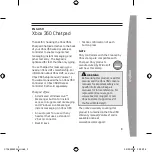
CHAPTER 5: SETTINGS
CONTROL ELEMENTS
L90 LINE CURRENT DIFFERENTIAL SYSTEM – INSTRUCTION MANUAL
5-377
5
This scheme uses an under-reaching Zone 1 distance element to key a transfer trip signal(s) to the remote end(s), where on
receipt, the DUTT pilot scheme operates without additional protection supervision. For proper operation of the scheme, the
Zone 1 phase and ground distance elements must be enabled, configured, and set per rules of distance relaying.
In single-pole tripping applications, the scheme uses local fault type identification provided by the Phase Selector together
with information received from the remote terminal(s). The latter can be coded into one, two, or four bits over the
communications channel.
The scheme generates output operands (
DUTT TX1
through
DUTT TX4
) that are used to transmit the direct under-reaching
signals to the remote end(s). Choices of communications channel include remote inputs/outputs and telecommunications
interfaces. When used with telecommunications facilities, assign the output operands to operate output contacts
connected to assert the individual bits at the interface.
To make the scheme a fully operational stand-alone feature, the scheme output operands must be configured to interface
with other relay functions, output contacts in particular. Typically, you program the output operands to initiate a trip,
breaker fail, and autoreclose, and drive a user-programmable LED as per user application. When used in conjunction with
the trip output element, the scheme is pre-configured to initiate trip, breaker fail, and single-pole autoreclose actions.
DUTT SCHEME BLOCK
— This setting allows the user to assign any FlexLogic operand to block the scheme. Contact inputs
from a pilot cut-out switch are typically used for this purpose.
DUTT SEAL-IN DELAY
— The output FlexLogic operand (
DUTT OP
) is produced according to the DUTT scheme logic. A seal-in
time delay is applied to this operand for coping with noisy communication channels such as a power line carrier. The
DUTT
SEAL-IN DELAY
is a minimum guaranteed duration of the
DUTT OP
pulse. As this operand activates the Trip Table of the DUTT
scheme, the trip operands
DUTT TRIP A
,
B
,
C
, and
3P
are sealed-in for the same period of time.
DUTT NO OF COMM BITS
— This setting specifies the number of bits available on the communications channel. With only one
bit available, the scheme sends the direct under-reaching transfer trip command on bit number 1 (
DUTT TX1
operand) and
responds to the direct trip command received on bit number 1 (
DUTT RX1
setting). The scheme uses only local fault type
identification provided by the Phase Selector to assert the output operands
DUTT TRIP A
,
B
,
C
, and
3P
.
DUTT RX1
through
DUTT RX4
— These settings allow the user to select the FlexLogic operands that represent the receive
signals for the scheme. Typically input contacts interfacing with a signaling system are used.
The DUTT scheme requires a secure and dependable signaling system. For this reason, a series/parallel combination of
receive signal “contacts” is often used. This is accomplished by using a multi-bit communications system to transmit
redundant copies of the
TX
signal (often via different paths) and building appropriate security logic (such as series (AND
gate) or 2-out-of-3 voting logic) with FlexLogic. The
DUTT RX1(4)
settings should be associated with the final (secure) TX
signals.
In single-bit applications,
DUTT RX1
must be used. In two-bit applications,
DUTT RX1
and
DUTT RX2
must be used. In four-bit
applications,
DUTT RX1
,
DUTT RX2
,
DUTT RX3
, and
DUTT RX4
must be used. In multi-terminal applications, connect the RX
signals from two or more remote terminals through OR gates in the FlexLogic, and configure the resulting signals as the
DUTT RX
inputs
















































